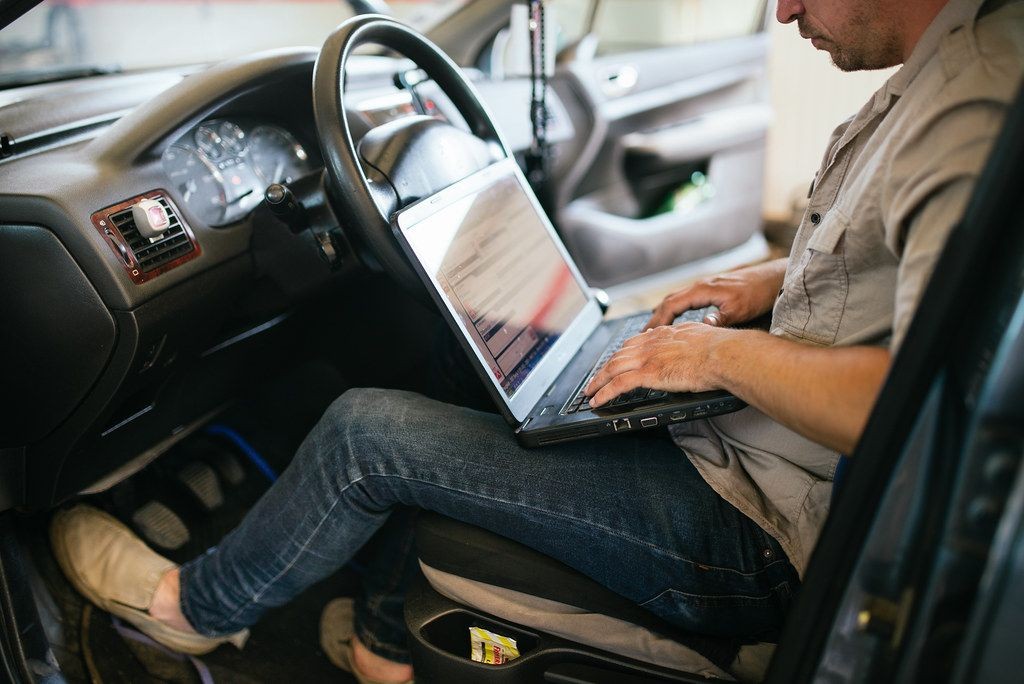Using Obd2 scanners has become increasingly important for car owners. Modern vehicles rely heavily on complex computer systems to manage various functions. When issues arise, understanding how to use an OBD2 scanner can save you time and money. This guide provides a comprehensive overview of OBD2 scanners, their functionality, and how to use them effectively.
What Does an OBD2 Scanner Do?
An OBD2 scanner, or On-Board Diagnostics scanner, is a device that connects to your car’s OBD2 port, typically located under the steering wheel. Using OBD2 allows you to access a wealth of information from the vehicle’s control units. This data includes diagnostic trouble codes (DTCs), often referred to as fault codes, which indicate specific problems within the system.
Alt: A mechanic using an OBD2 scanner to diagnose a car engine problem.
Using OBD2 also allows access to live data streams, offering real-time insights into various parameters such as engine speed, coolant temperature, and oxygen sensor readings. This information can be crucial in diagnosing intermittent issues or confirming suspected problems.
Types of OBD2 Scanners
Several types of OBD2 scanners are available, catering to different needs and budgets.
- Basic Code Readers: These affordable Bluetooth OBD2 scanners connect wirelessly to your smartphone or tablet. Using OBD2 with a code reader allows you to retrieve and clear basic fault codes.
- Mid-Range Scanners: These more advanced scanners offer additional functionality, including live data viewing, resetting service reminders, and performing certain service functions like activating brake pad replacement procedures.
- Professional Scanners: These high-end tools offer extensive capabilities, including advanced diagnostics, programming, coding, and bi-directional control over various vehicle systems. Using OBD2 at this level requires specialized knowledge and is typically utilized by professional mechanics.
How to Use an OBD2 Scanner: A Step-by-Step Guide
Using OBD2 scanners, even the basic models, can seem intimidating at first. Here’s a simple guide to get you started:
1. Locating the OBD2 Port
The OBD2 port is usually situated under the dashboard, near the steering wheel column.
Alt: Diagram showing common locations of the OBD2 port in a vehicle.
2. Connecting the Scanner
Plug the OBD2 scanner into the port. If using a Bluetooth scanner, ensure it’s paired with your device.
3. Turning on the Ignition
Turn the ignition key to the “on” position without starting the engine. This powers up the car’s computer system, allowing the scanner to communicate with it.
4. Selecting Your Vehicle
Some scanners may require you to input your vehicle’s year, make, and model. Others automatically detect this information.
5. Reading Fault Codes
Initiate a scan for fault codes. The scanner will display any stored DTCs.
6. Interpreting Fault Codes
Each code corresponds to a specific problem. Using OBD2 resources online or a repair manual, you can decipher the meaning of each code.
Alt: A close-up view of an OBD2 scanner displaying diagnostic information.
7. Clearing Fault Codes
After addressing the underlying issue, use the scanner to clear the fault codes.
Using OBD2 for Used Car Inspections
Using OBD2 scanners when inspecting a used car can reveal hidden problems. Scanning for fault codes before purchasing a used vehicle can save you from costly repairs down the road.
Conclusion
Using OBD2 scanners empowers car owners to diagnose and understand vehicle issues. From simple code readers to professional-grade tools, using OBD2 technology is an essential skill for anyone interested in car maintenance and repair. Remember that while using OBD2 can provide valuable diagnostic information, it’s crucial to consult with a qualified mechanic for complex repairs.


